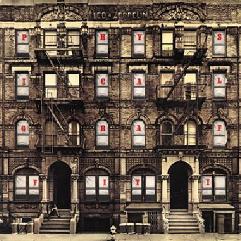Led Zeppelin - Physical Grafitti (1975)
Led Zeppelin - Physical Grafitti (1975)

Disc One:
1. "Custard Pie" (Jimmy Page, Robert Plant) – 4:13
2. "The Rover" (Page, Plant) – 5:37
3. "In My Time of Dying" (Page, Plant, John Paul Jones, John Bonham) – 11:05
4. "Houses of the Holy" (Page, Plant) – 4:02
5. "Trampled Under Foot" (Page, Plant, Jones) – 5:36
6. "Kashmir" (Page, Plant, Bonham) – 8:29
Disc Two:
1. "In the Light" (Page, Plant, Jones) – 8:46
2. "Bron-Yr-Aur" (Page) – 2:06
3. "Down by the Seaside" (Page, Plant) – 5:13
4. "Ten Years Gone" (Page, Plant) – 6:32
5. "Night Flight" (Jones, Page, Plant) – 3:36
6. "The Wanton Song" (Page, Plant) – 4:07
7. "Boogie with Stu" (Bonham, Jones, Page, Plant) – 3:53
8. "Black Country Woman" (Page, Plant) – 4:24
9. "Sick Again" (Page, Plant) – 4:42
Led Zeppelin returned from a nearly two-year hiatus in 1975 with the double-album Physical Graffiti, their most sprawling and ambitious work. Where Led Zeppelin IV and Houses of the Holy integrated influences on each song, the majority of the tracks on Physical Graffiti are individual stylistic workouts. The highlights are when Zeppelin incorporate influences and stretch out into new stylistic territory, most notably on the tense, Eastern-influenced "Kashmir." "Trampled Underfoot," with John Paul Jones' galloping keyboard, is their best funk-metal workout, while "Houses of the Holy" is their best attempt at pop, and "Down by the Seaside" is the closest they've come to country. Even the heavier blues -- the 11-minute "In My Time of Dying," the tightly wound "Custard Pie," and the monstrous epic "The Rover" -- are louder and more extended and textured than their previous work. Also, all of the heavy songs are on the first record, leaving the rest of the album to explore more adventurous territory, whether it's acoustic tracks or grandiose but quiet epics like the affecting "Ten Years Gone." The second half of Physical Graffiti feels like the group is cleaning the vaults out, issuing every little scrap of music they set to tape in the past few years. That means that the album is filled with songs that aren't quite filler, but don't quite match the peaks of the album, either. Still, even these songs have their merits -- "Sick Again" is the meanest, most decadent rocker they ever recorded, and the folky acoustic rock & roll of "Boogie with Stu" and "Black Country Woman" may be tossed off, but they have a relaxed, off-hand charm that Zeppelin never matched. It takes a while to sort out all of the music on the album, but Physical Graffiti captures the whole experience of Led Zeppelin at the top of their game better than any of their other albums. ---Stephen Thomas Erlewine, AllMusic Review
Wprawdzie najlepszą płytą najlepszego zespołu świata jest "Led Zeppelin II", ale ja postanowiłem wziąć na tapetę płytę mniej znaną, aczkolwiek niemalże równie dobrą. "Led Zeppelin II" była zbiorem utworów, które wystrzeliły nagle z głów muzyków. Była płytą od początku do końca spontaniczną, pełną energii i hard rockowej zadziorności. Wstrząsnęła całym światem - przypominam, że jak na rok 1969 był to bardzo ciężki materiał. Gdy w 1975 zespół wydał podwójną płytę "Physical Graffiti", nie odniosła takiego muzycznego sukcesu jak "Led Zeppelin II", ponieważ fani byli na to przygotowani. OK, "Physical Graffiti" jest podwójnym albumem, na którym znajduje się 8 premierowych kawałków i 7 odrzutów z lat 1970-1972. Płyta nadaje się do słuchania dosłownie wszędzie i zawsze.
Zaczynamy z bluesowym "Custard Pie". Super riff, Bonzo za garami wybija groovowy riff, a Robert śpiewa przesycony erotyzmem tekst. A później solo Page'a z Wah-Wah.
Lecimy dalej - "The Rover", odrzut z "Houses Of The Holy" - świetna gitara. Kolejną pozycją jest przeróbka utworu Boba Dylana "In My Time Of Dying". Przerażający riff grany slidem, jedenaście minut bluesa. Od zabawnego ataku kaszlu zaczyna się weselszy kawałek. "House Of The Holy", bo o nim mowa, to odrzut z płyty o tym samym tytule. Przyjemny riff i tekst. "Trampled Underfoot" - nawiązanie do Steviego Wondera i jego soulowych utworów. Świetny tekst, w którym Robert porównuje ciało kobiety do części samochodu. Świetne klawisze. Zeppelin leci dalej, "Kashmir" to kawałek historia, który można umieścić w jednym szeregu z "Whole Lotta Love", "Stairway To Heaven" i "No Quarter". Świetna orkiestracja, cudowny riff. Co ciekawe, żaden z Zeppelinów nigdy nie był w Kaszmirze. Pierwszą stronę kasety wieńczy gitarowy popis Page'a "Bron Y Aur". Prześliczny akustyczny kawałek. Te melodie...
Drugą stronę rozpoczynają orientalne klawisze i wchodzi "In The Light", ciężki riff, fajne melodie w refrenie. W kolejce stoi już "Down By The Seaside", od którego na kilometr powiewa morzem. Akustyczne intro gitary wprowadza nas w "Ten Years Gone", gdzie Robert opowiada o swojej przyjaciółce, która kazała mu wybierać pomiędzy sobą a muzyką. Chyba nikt nie ma wątpliwości co wzięło górę? OK. Następny utwór może kojarzyć się z Rolling Stones. "Night Flight", bo o nim mowa, to typowy rockowy kawałek, klawisze i gitary bez zastrzeżeń. Później kilkuminutowy czad w postaci "The Wanton Song" - super riff. Wyluzowanie i kolejna perełka - "Boogie With Stu". Świetny numer na pianino, bębenek, akustyka plus solo na mandolinie. Następny akustyczny kawałek to luźny jam grany w ogródku posiadłości Micka Jaggera "Stargroves". Na początku słychać nawet przelatujący samolot. Na koniec killer, czyli "Sick Again". Cool gitary i tekst.
Tak kończy się jedna z najlepszych płyt w historii rocka. Warto ją kupić za każde pieniądze!!! ---Wickerman, rockmetal.pl
download (mp3 @320 kbs):
yandex mediafire uloz.to cloud.mail.ru gett
Last Updated (Wednesday, 13 June 2018 11:14)








